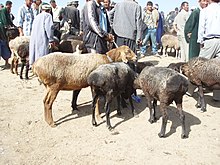Fat-tailed sheep
Fat-tailed sheep are a group of domestic sheep breeds that have been around for about 6000 years. Fat-tailed sheep, unlike other sheep, store a large part of their body fat in their tails. The fat-tailed sheep play no role in Europe. They are held in North Africa , the Middle East and the “Fertile Crescent” region , among others .
The area of the Fertile Crescent is considered to be the likely area of origin. The different breeds of fat-tailed sheep are comparatively similar genetically. Molecular genetic data (mitochondrial DNA) show that one of five reconstructed maternal lineages of domestic sheep (line C) is mainly found in fat-tailed sheep.
The oldest surviving images are around 5000 years old and were found in Uruk . Fat-tailed sheep are probably not the oldest domesticated sheep, but targeted further breeding. There are several hundred variants of tail shapes worldwide. Herodotus mentions fat-tailed sheep with very projecting tails in a report about the Arabia of that time, which allegedly could only move without problems with the help of mobile pedestals.
Today it is estimated that around 25 percent of all sheep worldwide are fat-tailed sheep. It plays an important role in North Africa, especially in Tunisia , Egypt , the countries of the Arabian Peninsula and Turkey . They are also found in parts of Asia. The wool from these sheep is hard and is rarely used commercially.
The principle of fat storage in the tail of these sheep corresponds to the storage function of the hump in camels . However, they are basically able to store body fat in other places as well, as tests have shown in which the tails of lambs were removed. This is also proof that the fat-tailed sheep is the result of targeted breeding. The fat stored here is soft and much more fluid in consistency than fat stored elsewhere in the body.
In the Arab and the Persian cuisine of this fat comes from the Middle Ages in numerous recipes. It has always been used primarily to prepare meat. The meat of fat-tailed sheep is leaner than that of other domestic sheep and is highly valued in the regions where it is distributed. The animals are also considered good milk suppliers.
Races
literature
- Alan Davidson: The Oxford Companion to Food , 2nd ed. Oxford 2006, article Fat-tailed sheep , p. 293 f.
Individual evidence
- ↑ Joana Rocha, Shanyuan Chen, Albano Beja-Pereira (2011) Molecular evidence for fat-tailed sheep domestication. Tropical Animal Health and Production 43 (7): 1237-1243. (online: http://link.springer.com/content/pdf/10.1007%2Fs11250-011-9854-9.pdf )

